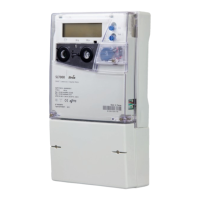6.13.2. Event histories
In addition to the typical event data (event type and time stamp) recorded in the logbook, some specific events
have further associated data elements that also require storage.
These extra data elements are stored in Event History buffers.
The buffer architecture is circular and operates in a first-in first-out (FIFO) fashion, so when the buffer becomes
full, the oldest data elements are overwritten with the latest entries. Therefore, if the data to be overwritten has
not been read, it will be lost.
Event history storage is non-configurable and any data associated with these specific events is always stored,
even if the event itself is not selected to be recorded in the logbook.
The following table contains a typical list of events that are stored in history buffers (these may change due to
meter firmware revision):
Event Maximum
Index change 100
Day profile change 10
Season change 2
Voltage sags 10
Voltage swells 10
Voltage cuts 10
Long power failures 10
Cover openings 10
Current reversals 10
COSEM user connections 10
6.13.3. Alarm type and classification
Alarm types
In addition to logbook events, the meter manages two types of alarm:
• Fatal
These alarms cause the meter to enter the non-operational mode (STOP displayed on the LCD) where only
instantaneous values are processed and no further registration of energy or demand/load profile calculation
is performed.
The meter should be removed from the installation site and tested. It will still contain all the metered data
collected up to the point the fatal alarm occurred.
• Non-fatal
The meter is still able to operate during this type of alarm and some of these alarms are purely informative.
Alarm classification
Alarms are further classified according to the way they clear, as follows:
• Self-healing
These alarms automatically clear when the alarm state disappears.
• Trapped
These alarms will only clear when a reset command is performed (via communication or pushbutton) even if
the alarm state has disappeared.

